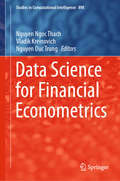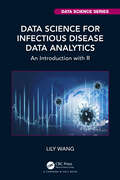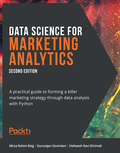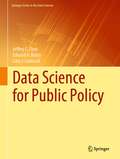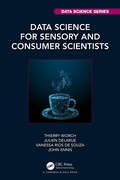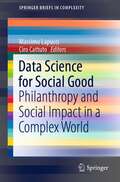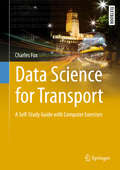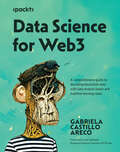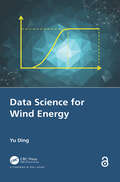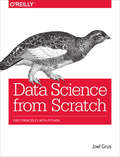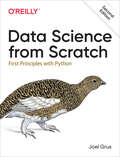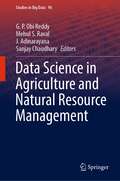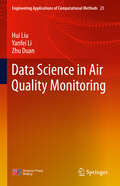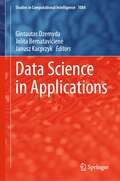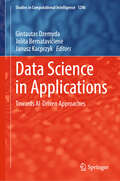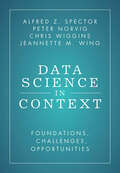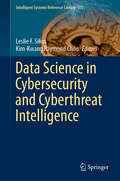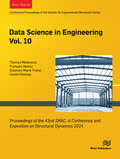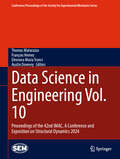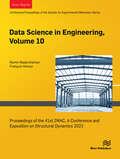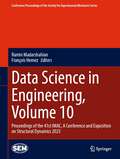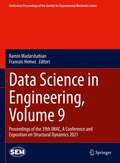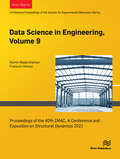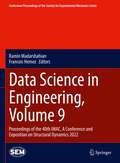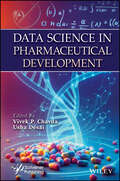- Table View
- List View
Data Science for Financial Econometrics (Studies in Computational Intelligence #898)
by Vladik Kreinovich Nguyen Ngoc Thach Nguyen Duc TrungThis book offers an overview of state-of-the-art econometric techniques, with a special emphasis on financial econometrics. There is a major need for such techniques, since the traditional way of designing mathematical models – based on researchers’ insights – can no longer keep pace with the ever-increasing data flow. To catch up, many application areas have begun relying on data science, i.e., on techniques for extracting models from data, such as data mining, machine learning, and innovative statistics. In terms of capitalizing on data science, many application areas are way ahead of economics. To close this gap, the book provides examples of how data science techniques can be used in economics. Corresponding techniques range from almost traditional statistics to promising novel ideas such as quantum econometrics. Given its scope, the book will appeal to students and researchers interested in state-of-the-art developments, and to practitioners interested in using data science techniques.
Data Science for Infectious Disease Data Analytics: An Introduction with R (Chapman & Hall/CRC Data Science Series)
by Lily WangData Science for Infectious Disease Data Analytics: An Introduction with R provides an overview of modern data science tools and methods that have been developed specifically to analyze infectious disease data. With a quick start guide to epidemiological data visualization and analysis in R, this book spans the gulf between academia and practices providing many lively, instructive data analysis examples using the most up-to-date data, such as the newly discovered coronavirus disease (COVID-19). The primary emphasis of this book is the data science procedures in epidemiological studies, including data wrangling, visualization, interpretation, predictive modeling, and inference, which is of immense importance due to increasingly diverse and nonexperimental data across a wide range of fields. The knowledge and skills readers gain from this book are also transferable to other areas, such as public health, business analytics, environmental studies, or spatio-temporal data visualization and analysis in general. Aimed at readers with an undergraduate knowledge of mathematics and statistics, this book is an ideal introduction to the development and implementation of data science in epidemiology. Features Describes the entire data science procedure of how the infectious disease data are collected, curated, visualized, and fed to predictive models, which facilitates effective communication between data sources, scientists, and decision-makers. Explains practical concepts of infectious disease data and provides particular data science perspectives. Overview of the unique features and issues of infectious disease data and how they impact epidemic modeling and projection. Introduces various classes of models and state-of-the-art learning methods to analyze infectious diseases data with valuable insights on how different models and methods could be connected.
Data Science for Marketing Analytics: A practical guide to forming a killer marketing strategy through data analysis with Python, 2nd Edition
by Vishwesh Ravi Shrimali Mirza Rahim Baig Gururajan GovindanTurbocharge your marketing plans by making the leap from simple descriptive statistics in Excel to sophisticated predictive analytics with the Python programming languageKey FeaturesUse data analytics and machine learning in a sales and marketing contextGain insights from data to make better business decisionsBuild your experience and confidence with realistic hands-on practiceBook DescriptionUnleash the power of data to reach your marketing goals with this practical guide to data science for business.This book will help you get started on your journey to becoming a master of marketing analytics with Python. You'll work with relevant datasets and build your practical skills by tackling engaging exercises and activities that simulate real-world market analysis projects.You'll learn to think like a data scientist, build your problem-solving skills, and discover how to look at data in new ways to deliver business insights and make intelligent data-driven decisions.As well as learning how to clean, explore, and visualize data, you'll implement machine learning algorithms and build models to make predictions. As you work through the book, you'll use Python tools to analyze sales, visualize advertising data, predict revenue, address customer churn, and implement customer segmentation to understand behavior.By the end of this book, you'll have the knowledge, skills, and confidence to implement data science and machine learning techniques to better understand your marketing data and improve your decision-making.What you will learnLoad, clean, and explore sales and marketing data using pandasForm and test hypotheses using real data sets and analytics toolsVisualize patterns in customer behavior using MatplotlibUse advanced machine learning models like random forest and SVMUse various unsupervised learning algorithms for customer segmentationUse supervised learning techniques for sales predictionEvaluate and compare different models to get the best outcomesOptimize models with hyperparameter tuning and SMOTEWho this book is forThis marketing book is for anyone who wants to learn how to use Python for cutting-edge marketing analytics. Whether you're a developer who wants to move into marketing, or a marketing analyst who wants to learn more sophisticated tools and techniques, this book will get you on the right path.Basic prior knowledge of Python and experience working with data will help you access this book more easily.
Data Science for Public Policy (Springer Series in the Data Sciences)
by Jeffrey C. Chen Edward A. Rubin Gary J. CornwallThis textbook presents the essential tools and core concepts of data science to public officials, policy analysts, and economists among others in order to further their application in the public sector. An expansion of the quantitative economics frameworks presented in policy and business schools, this book emphasizes the process of asking relevant questions to inform public policy. Its techniques and approaches emphasize data-driven practices, beginning with the basic programming paradigms that occupy the majority of an analyst’s time and advancing to the practical applications of statistical learning and machine learning. The text considers two divergent, competing perspectives to support its applications, incorporating techniques from both causal inference and prediction. Additionally, the book includes open-sourced data as well as live code, written in R and presented in notebook form, which readers can use and modify to practice working with data.
Data Science for Sensory and Consumer Scientists (Chapman & Hall/CRC Data Science Series)
by John Ennis Thierry Worch Julien Delarue Vanessa Rios De SouzaData Science for Sensory and Consumer Scientists is a comprehensive textbook that provides a practical guide to using data science in the field of sensory and consumer science through real-world applications. It covers key topics including data manipulation, preparation, visualization, and analysis, as well as automated reporting, machine learning, text analysis, and dashboard creation. Written by leading experts in the field, this book is an essential resource for anyone looking to master the tools and techniques of data science and apply them to the study of consumer behavior and sensory-led product development. Whether you are a seasoned professional or a student just starting out, this book is the ideal guide to using data science to drive insights and inform decision-making in the sensory and consumer sciences. Key Features: • Elucidation of data scientific workflow. • Introduction to reproducible research. • In-depth coverage of data-scientific topics germane to sensory and consumer science. • Examples based in industrial practice used throughout the book
Data Science for Social Good: Philanthropy and Social Impact in a Complex World (SpringerBriefs in Complexity)
by Massimo Lapucci Ciro CattutoThis book is a collection of reflections by thought leaders at first-mover organizations in the exploding field of "Data Science for Social Good", meant as the application of knowledge from computer science, complex systems and computational social science to challenges such as humanitarian response, public health, sustainable development. The book provides both an overview of scientific approaches to social impact – identifying a social need, targeting an intervention, measuring impact – and the complementary perspective of funders and philanthropies that are pushing forward this new sector. This book will appeal to students and researchers in the rapidly growing field of data science for social impact, to data scientists at companies whose data could be used to generate more public value, and to decision makers at nonprofits, foundations, and agencies that are designing their own agenda around data.
Data Science for Transport: A Self-study Guide With Computer Exercises (Springer Textbooks In Earth Sciences, Geography And Environment Ser.)
by Charles FoxThe quantity, diversity and availability of transport data is increasing rapidly, requiring new skills in the management and interrogation of data and databases. Recent years have seen a new wave of 'big data', 'Data Science', and 'smart cities' changing the world, with the Harvard Business Review describing Data Science as the "sexiest job of the 21st century". Transportation professionals and researchers need to be able to use data and databases in order to establish quantitative, empirical facts, and to validate and challenge their mathematical models, whose axioms have traditionally often been assumed rather than rigorously tested against data. This book takes a highly practical approach to learning about Data Science tools and their application to investigating transport issues. The focus is principally on practical, professional work with real data and tools, including business and ethical issues."Transport modeling practice was developed in a data poor world, and many of our current techniques and skills are building on that sparsity. In a new data rich world, the required tools are different and the ethical questions around data and privacy are definitely different. I am not sure whether current professionals have these skills; and I am certainly not convinced that our current transport modeling tools will survive in a data rich environment. This is an exciting time to be a data scientist in the transport field. We are trying to get to grips with the opportunities that big data sources offer; but at the same time such data skills need to be fused with an understanding of transport, and of transport modeling. Those with these combined skills can be instrumental at providing better, faster, cheaper data for transport decision- making; and ultimately contribute to innovative, efficient, data driven modeling techniques of the future. It is not surprising that this course, this book, has been authored by the Institute for Transport Studies. To do this well, you need a blend of academic rigor and practical pragmatism. There are few educational or research establishments better equipped to do that than ITS Leeds". - Tom van Vuren, Divisional Director, Mott MacDonald"WSP is proud to be a thought leader in the world of transport modelling, planning and economics, and has a wide range of opportunities for people with skills in these areas. The evidence base and forecasts we deliver to effectively implement strategies and schemes are ever more data and technology focused a trend we have helped shape since the 1970's, but with particular disruption and opportunity in recent years. As a result of these trends, and to suitably skill the next generation of transport modellers, we asked the world-leading Institute for Transport Studies, to boost skills in these areas, and they have responded with a new MSc programme which you too can now study via this book." - Leighton Cardwell, Technical Director, WSP."From processing and analysing large datasets, to automation of modelling tasks sometimes requiring different software packages to "talk" to each other, to data visualization, SYSTRA employs a range of techniques and tools to provide our clients with deeper insights and effective solutions. This book does an excellent job in giving you the skills to manage, interrogate and analyse databases, and develop powerful presentations. Another important publication from ITS Leeds." - Fitsum Teklu, Associate Director (Modelling & Appraisal) SYSTRA Ltd"Urban planning has relied for decades on statistical and computational practices that have little to do with mainstream data science. Information is still often used as evidence on the impact of new infrastructure even when it hardly contains any valid evidence. This book is an extremely welcome effort to provide young professionals with the skills needed to analyse how cities and transport networks actually work. The book is also highly relevant to anyone who will later want to build digital solutions to optimise urban travel based on emerging data sources". - Yaron Hollander, author of "T
Data Science for Web3: A comprehensive guide to decoding blockchain data with data analysis basics and machine learning cases
by Gabriela Castillo ArecoBe part of the future of Web3, decoding blockchain data to build trust in the next-generation internetKey FeaturesBuild a deep understanding of the fundamentals of blockchain analyticsExtract actionable business insights by modeling blockchain dataShowcase your work and gain valuable experience to seize opportunities in the Web3 ecosystemPurchase of the print or Kindle book includes a free PDF eBookBook DescriptionData is the new oil and Web3 is generating it at an unprecedented rate. Complete with practical examples, detailed explanations, and ideas for portfolio development, this comprehensive book serves as a step-by-step guide covering the industry best practices, tools, and resources needed to easily navigate the world of data in Web3. You’ll begin by acquiring a solid understanding of key blockchain concepts and the fundamental data science tools essential for Web3 projects. The subsequent chapters will help you explore the main data sources that can help address industry challenges, decode smart contracts, and build DeFi- and NFT-specific datasets. You’ll then tackle the complexities of feature engineering specific to blockchain data and familiarize yourself with diverse machine learning use cases that leverage Web3 data. The book includes interviews with industry leaders providing insights into their professional journeys to drive innovation in the Web 3 environment. Equipped with experience in handling crypto data, you’ll be able to demonstrate your skills in job interviews, academic pursuits, or when engaging potential clients. By the end of this book, you’ll have the essential tools to undertake end-to-end data science projects utilizing blockchain data, empowering you to help shape the next-generation internet.What you will learnUnderstand the core components of blockchain transactions and blocksIdentify reliable sources of on-chain and off-chain data to build robust datasetsUnderstand key Web3 business questions and how data science can offer solutionsBuild your skills to create and query NFT- and DeFi-specific datasetsImplement a machine learning toolbox with real-world use cases in the Web3 spaceWho this book is forThis book is designed for data professionals—data analysts, data scientists, or data engineers— and business professionals, aiming to acquire the skills for extracting data from the Web3 ecosystem, as it demonstrates how to effectively leverage data tools for in-depth analysis of blockchain transactional data. If you seek hands-on experience, you'll find value in the shared repository, enabling you to experiment with the provided solutions. While not mandatory, a basic understanding of statistics, machine learning, and Python will enhance your learning experience.
Data Science for Wind Energy
by Yu DingData Science for Wind Energy provides an in-depth discussion on how data science methods can improve decision making for wind energy applications, near-ground wind field analysis and forecast, turbine power curve fitting and performance analysis, turbine reliability assessment, and maintenance optimization for wind turbines and wind farms. A broad set of data science methods covered, including time series models, spatio-temporal analysis, kernel regression, decision trees, kNN, splines, Bayesian inference, and importance sampling. More importantly, the data science methods are described in the context of wind energy applications, with specific wind energy examples and case studies. Please also visit the author’s book site at https://aml.engr.tamu.edu/book-dswe.Features Provides an integral treatment of data science methods and wind energy applications Includes specific demonstration of particular data science methods and their use in the context of addressing wind energy needs Presents real data, case studies and computer codes from wind energy research and industrial practice Covers material based on the author's ten plus years of academic research and insights
Data Science from Scratch: First Principles with Python
by Joel GrusData science libraries, frameworks, modules, and toolkits are great for doing data science, but they're also a good way to dive into the discipline without actually understanding data science. In this book, you'll learn how many of the most fundamental data science tools and algorithms work by implementing them from scratch.If you have an aptitude for mathematics and some programming skills, author Joel Grus will help you get comfortable with the math and statistics at the core of data science, and with hacking skills you need to get started as a data scientist. Today's messy glut of data holds answers to questions no one's even thought to ask. This book provides you with the know-how to dig those answers out.Get a crash course in PythonLearn the basics of linear algebra, statistics, and probability--and understand how and when they're used in data scienceCollect, explore, clean, munge, and manipulate dataDive into the fundamentals of machine learningImplement models such as k-nearest Neighbors, Naive Bayes, linear and logistic regression, decision trees, neural networks, and clusteringExplore recommender systems, natural language processing, network analysis, MapReduce, and databases
Data Science from Scratch: First Principles with Python
by Joel GrusData science libraries, frameworks, modules, and toolkits are great for doing data science, but they’re also a good way to dive into the discipline without actually understanding data science. With this updated second edition, you’ll learn how many of the most fundamental data science tools and algorithms work by implementing them from scratch.If you have an aptitude for mathematics and some programming skills, author Joel Grus will help you get comfortable with the math and statistics at the core of data science, and with hacking skills you need to get started as a data scientist. Today’s messy glut of data holds answers to questions no one’s even thought to ask. This book provides you with the know-how to dig those answers out.
Data Science in Agriculture and Natural Resource Management (Studies in Big Data #96)
by Sanjay Chaudhary G. P. Obi Reddy Mehul S. Raval J. AdinarayanaThis book aims to address emerging challenges in the field of agriculture and natural resource management using the principles and applications of data science (DS). The book is organized in three sections, and it has fourteen chapters dealing with specialized areas. The chapters are written by experts sharing their experiences very lucidly through case studies, suitable illustrations and tables. The contents have been designed to fulfil the needs of geospatial, data science, agricultural, natural resources and environmental sciences of traditional universities, agricultural universities, technological universities, research institutes and academic colleges worldwide. It will help the planners, policymakers and extension scientists in planning and sustainable management of agriculture and natural resources. The authors believe that with its uniqueness the book is one of the important efforts in the contemporary cyber-physical systems.
Data Science in Air Quality Monitoring (Engineering Applications of Computational Methods #23)
by Hui Liu Yanfei Li Zhu DuanThis book presents a series of state-of-the-art methods for air quality monitoring in various engineering environment by using data science. In the book, the data-driven key techniques of the preprocessing, decomposition, identification, clustering, forecasting and interpolation of the air quality monitoring are explained in details with lots of experimental simulation. The book can provide important reference for the development of data science technologies in engineering air quality monitoring. The book can be used for students, engineers, scientists and managers in the fields of environmental engineering, atmospheric science, urban climate, civil engineering, traffic and vehicle engineering, etc.
Data Science in Applications (Studies in Computational Intelligence #1084)
by Janusz Kacprzyk Gintautas Dzemyda Jolita BernatavičienėThis book provides an overview of a wide range of relevant applications and reveals how to solve them. Many of the latest applications in finance, technology, education, medicine and other important and relevant fields are data-driven. The volumes of data are enormous. Specific methods need to be developed or adapted to solve a particular problem. It illustrates data science in applications. These applications have in common the discovery of knowledge in data and the use of this knowledge to make real decisions. The set of examples presented serves as a recipe book for their direct application to similar problems or as a guide for the development of new, more sophisticated approaches. The intended readership is data scientists looking for appropriate solutions to their problems. In addition, the examples provided serves as material for lectures at universities.
Data Science in Applications: Towards AI-Driven Approaches (Studies in Computational Intelligence #1206)
by Janusz Kacprzyk Gintautas Dzemyda Jolita BernatavičienėThis book provides a forum for presenting and discussing new and promising ideas in the broadly understood data science field and scope. Data science is a broad discipline. Related and partially overlapping fields are data mining, pattern recognition, neurocomputing, statistics, mathematics, data visualisation, databases, data processing, knowledge discovery in databases, big data analysis, computer science, cloud computing, machine learning, and artificial intelligence. Recent research has focused on unlocking the new possibilities of artificial intelligence, not only from a theoretical point of view but also from an applied perspective. In light of recent developments and trends in these fields, the topics covered in the book have been expanded and extended to include various aspects of artificial intelligence (AI), advanced data analysis, data analytics, machine learning, and multimedia, both from a theoretical and a practical application perspective. All of these are coming together, so we are seeing a variety of AI-driven approaches. This book contains 12 chapters by data science researchers. They are divided into &“AI-supported multimedia systems&” and &“Developments, challenges, and applications of advanced data analysis and machine learning.&” The first part of the book contains chapters that discuss various aspects of multimedia systems, notably text, voice, and image, in particular from the point of view of how new developments in AI, advanced data analyses, etc., can provide new, effective and efficient, tools and techniques, maybe even imply research and implementation breakthroughs. The second part of the book, &“Developments, challenges and applications of advanced data analysis and machine learning,&” is concerned with various aspects, problems, solutions, and applications for new sophisticated tools and techniques of data analyses, data analytics, and machine learning providing tools and techniques to take advantage of what is available in data.
Data Science in Context: Foundations, Challenges, Opportunities
by Peter Norvig Jeannette M. Wing Alfred Z. Spector Chris WigginsData science is the foundation of our modern world. It underlies applications used by billions of people every day, providing new tools, forms of entertainment, economic growth, and potential solutions to difficult, complex problems. These opportunities come with significant societal consequences, raising fundamental questions about issues such as data quality, fairness, privacy, and causation. In this book, four leading experts convey the excitement and promise of data science and examine the major challenges in gaining its benefits and mitigating its harms. They offer frameworks for critically evaluating the ingredients and the ethical considerations needed to apply data science productively, illustrated by extensive application examples. The authors' far-ranging exploration of these complex issues will stimulate data science practitioners and students, as well as humanists, social scientists, scientists, and policy makers, to study and debate how data science can be used more effectively and more ethically to better our world.
Data Science in Cybersecurity and Cyberthreat Intelligence (Intelligent Systems Reference Library #177)
by Leslie F. Sikos Kim-Kwang Raymond ChooThis book presents a collection of state-of-the-art approaches to utilizing machine learning, formal knowledge bases and rule sets, and semantic reasoning to detect attacks on communication networks, including IoT infrastructures, to automate malicious code detection, to efficiently predict cyberattacks in enterprises, to identify malicious URLs and DGA-generated domain names, and to improve the security of mHealth wearables. This book details how analyzing the likelihood of vulnerability exploitation using machine learning classifiers can offer an alternative to traditional penetration testing solutions. In addition, the book describes a range of techniques that support data aggregation and data fusion to automate data-driven analytics in cyberthreat intelligence, allowing complex and previously unknown cyberthreats to be identified and classified, and countermeasures to be incorporated in novel incident response and intrusion detection mechanisms.
Data Science in Engineering Vol. 10: Proceedings of the 42nd IMAC, A Conference and Exposition on Structural Dynamics 2024
by Austin Downey Thomas Matarazzo Eleonora Maria Tronci Franíois HemezData Science in Engineering, Volume 10: Proceedings of the 42nd IMAC, A Conference and Exposition on Structural Dynamics, 2024, the tenth volume of ten from the Conference brings together contributions to this important area of research and engineering. The collection presents early findings and case studies on fundamental and applied aspects of Data Science in Engineering, including papers on: Novel Data-driven Analysis Methods Deep Learning Gaussian Process Analysis Real-time Video-based Analysis Applications to Nonlinear Dynamics and Damage Detection Data-driven System Prognostics.
Data Science in Engineering Vol. 10: Proceedings of the 42nd IMAC, A Conference and Exposition on Structural Dynamics 2024 (Conference Proceedings of the Society for Experimental Mechanics Series)
by François Hemez Austin Downey Thomas Matarazzo Eleonora Maria TronciData Science in Engineering, Volume 10: Proceedings of the 42nd IMAC, A Conference and Exposition on Structural Dynamics, 2024, the tenth volume of ten from the Conference brings together contributions to this important area of research and engineering. The collection presents early findings and case studies on fundamental and applied aspects of Data Science in Engineering, including papers on: Novel Data-driven Analysis Methods Deep Learning Gaussian Process Analysis Real-time Video-based Analysis Applications to Nonlinear Dynamics and Damage Detection Data-driven System Prognostics
Data Science in Engineering, Volume 10: Proceedings of the 41st IMAC, A Conference and Exposition on Structural Dynamics 2023
by Ramin Madarshahian François HemezData Science in Engineering, Volume 10: Proceedings of the 41st IMAC, A Conference and Exposition on Structural Dynamics, 2023, the tenth volume of ten from the Conference brings together contributions to this important area of research and engineering. The collection presents early findings and case studies on fundamental and applied aspects of Data Science in Engineering, including papers on: Novel Data-driven Analysis Methods Deep Learning Gaussian Process Analysis Real-time Video-based Analysis Applications to Nonlinear Dynamics and Damage Detection High-rate Structural Monitoring and Prognostics.
Data Science in Engineering, Volume 10: Proceedings of the 41st IMAC, A Conference and Exposition on Structural Dynamics 2023 (Conference Proceedings of the Society for Experimental Mechanics Series)
by Ramin Madarshahian François HemezData Science in Engineering, Volume 10: Proceedings of the 41st IMAC, A Conference and Exposition on Structural Dynamics, 2023, the tenth volume of ten from the Conference brings together contributions to this important area of research and engineering. The collection presents early findings and case studies on fundamental and applied aspects of Data Science in Engineering, including papers on:Novel Data-driven Analysis MethodsDeep Learning Gaussian Process AnalysisReal-time Video-based AnalysisApplications to Nonlinear Dynamics and Damage DetectionHigh-rate Structural Monitoring and Prognostics
Data Science in Engineering, Volume 9: Proceedings of the 39th IMAC, A Conference and Exposition on Structural Dynamics 2021 (Conference Proceedings of the Society for Experimental Mechanics Series)
by Ramin Madarshahian Francois HemezData Science and Engineering Volume 9: Proceedings of the 39th IMAC, A Conference and Exposition on Structural Dynamics, 2021, the ninth volume of nine from the Conference, brings together contributions to this important area of research and engineering. The collection presents early findings and case studies on fundamental and applied aspects of Data Science in Engineering, including papers on:Data Science in Engineering ApplicationsEngineering MathematicsComputational Methods in Engineering
Data Science in Engineering, Volume 9: Proceedings of the 40th IMAC, A Conference and Exposition on Structural Dynamics 2022
by Ramin Madarshahian Francois HemezData Science in Engineering, Volume 9: Proceedings of the 40th IMAC, A Conference and Exposition on Structural Dynamics, 2022, the nineth volume of nine from the Conference brings together contributions to this important area of research and engineering. The collection presents early findings and case studies on fundamental and applied aspects of Data Science in Engineering, including papers on: Novel Data-driven Analysis Methods Deep Learning Gaussian Process Analysis Real-time Video-based Analysis Applications to Nonlinear Dynamics and Damage Detection High-rate Structural Monitoring and Prognostics.
Data Science in Engineering, Volume 9: Proceedings of the 40th IMAC, A Conference and Exposition on Structural Dynamics 2022 (Conference Proceedings of the Society for Experimental Mechanics Series)
by Ramin Madarshahian Francois HemezData Science in Engineering, Volume 9: Proceedings of the 40th IMAC, A Conference and Exposition on Structural Dynamics, 2022, the nineth volume of nine from the Conference brings together contributions to this important area of research and engineering. The collection presents early findings and case studies on fundamental and applied aspects of Data Science in Engineering, including papers on:Novel Data-driven Analysis MethodsDeep Learning Gaussian Process AnalysisReal-time Video-based AnalysisApplications to Nonlinear Dynamics and Damage DetectionHigh-rate Structural Monitoring and Prognostics
Data Science in Pharmaceutical Development
by Usha Desai Vivek P. ChavdaThis book is an indispensable guide for anyone looking to understand how AI, machine learning, and data science are revolutionizing drug discovery, development, and delivery, offering practical insights and addressing crucial real-world applications and considerations. Data Science in Pharmaceutical Development offers a comprehensive and forward-looking exploration of how artificial intelligence, machine learning, and data science are reshaping the pharmaceutical landscape. From the earliest stages of drug discovery to advanced delivery systems and post-market surveillance, this volume bridges the gap between innovation and real-world application. Practical examples and case studies bring to life the transformative potential of AI-powered tools in accelerating research, enhancing patient outcomes, and improving efficiency throughout the pharmaceutical product lifecycle. Designed for researchers, industry professionals, and students alike, this book not only showcases cutting-edge technologies but also addresses the ethical, legal, and regulatory considerations critical to their implementation. Whether you’re navigating the complexities of clinical trials, optimizing supply chains, or seeking to understand the implications of smart drug delivery systems, this book is an indispensable guide to the future of medicine and healthcare innovation. Readers will find the book: Explores the role of AI, machine learning, and data science across the entire pharmaceutical pipeline—from drug discovery and clinical trials to smart drug delivery systems; Rich with real-world case studies and practical examples, connecting theory to implementation in modern pharmaceutical research and development; Introduces advanced topics like predictive modeling, personalized medicine, IoT, pharmacovigilance, and nanotechnology-enabled drug delivery; Highlights emerging trends, ethical considerations, and the regulatory framework surrounding AI in healthcare. Audience Research scholars, pharmacy students, pharmaceutical process engineers, and pharmacy professionals in the pharmaceutical and biopharmaceutical industry who are working in drug discovery, chemical biology, computational chemistry, medicinal chemistry, and bioinformatics.
